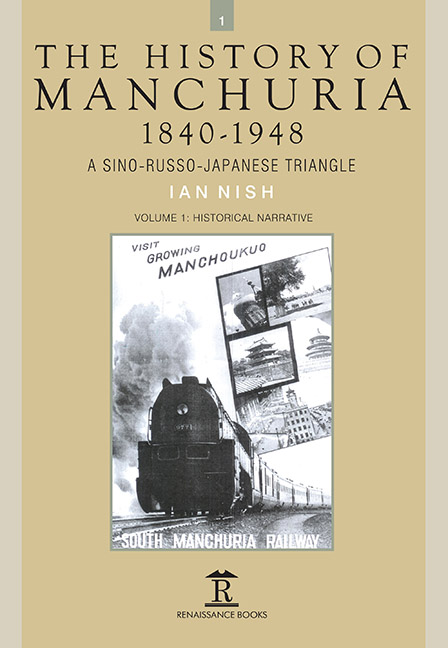93 results
11 - Sir Edward Grey, 1862–1933 [Viscount Grey of Falloden] Foreign Secretary, 1905–16
-
-
- Book:
- British Foreign Secretaries and Japan 1850-1990
- Published by:
- Amsterdam University Press
- Published online:
- 30 April 2022
- Print publication:
- 01 June 2018, pp 115-123
-
- Chapter
- Export citation
7 - Lord Rosebery, 1847–1929 [5th Earl of Rosebery] Foreign Secretary, 1886, 1892–94 Prime Minister, 1894–95
-
-
- Book:
- British Foreign Secretaries and Japan 1850-1990
- Published by:
- Amsterdam University Press
- Published online:
- 30 April 2022
- Print publication:
- 01 June 2018, pp 74-81
-
- Chapter
- Export citation
12 - Arthur James Balfour, 1848–1930 [lst Earl of Balfour] Foreign Secretary, 1916–19 Prime Minister, 1902–05
-
-
- Book:
- British Foreign Secretaries and Japan 1850-1990
- Published by:
- Amsterdam University Press
- Published online:
- 30 April 2022
- Print publication:
- 01 June 2018, pp 124-132
-
- Chapter
- Export citation
13 - Lord Curzon, 1859–1925 [George Nathaniel, 1st Marquess Curzon of Kedleston] Foreign Secretary, 1919–24
-
-
- Book:
- British Foreign Secretaries and Japan 1850-1990
- Published by:
- Amsterdam University Press
- Published online:
- 30 April 2022
- Print publication:
- 01 June 2018, pp 133-142
-
- Chapter
- Export citation
11 - London School of Economics
-
-
- Book:
- Japanese Studies in Britain
- Published by:
- Amsterdam University Press
- Published online:
- 13 May 2022
- Print publication:
- 01 October 2016, pp 128-138
-
- Chapter
- Export citation

The History of Manchuria, 1840-1948
- A Sino-Russo-Japanese Triangle
-
- Published by:
- Amsterdam University Press
- Published online:
- 18 November 2023
- Print publication:
- 01 September 2016
List of Maps
-
- Book:
- The History of Manchuria, 1840-1948
- Published by:
- Amsterdam University Press
- Published online:
- 18 November 2023
- Print publication:
- 01 September 2016, pp xxvii-xxviii
-
- Chapter
- Export citation
Chapter 1 - 1840–1894
-
- Book:
- The History of Manchuria, 1840-1948
- Published by:
- Amsterdam University Press
- Published online:
- 18 November 2023
- Print publication:
- 01 September 2016, pp 1-23
-
- Chapter
- Export citation
List of Abbreviations
-
- Book:
- The History of Manchuria, 1840-1948
- Published by:
- Amsterdam University Press
- Published online:
- 18 November 2023
- Print publication:
- 01 September 2016, pp xxv-xxvi
-
- Chapter
- Export citation
Chapter Three - Prelude to the Russo-Japanese War, 1900–1905
-
- Book:
- The History of Manchuria, 1840-1948
- Published by:
- Amsterdam University Press
- Published online:
- 18 November 2023
- Print publication:
- 01 September 2016, pp 39-56
-
- Chapter
- Export citation
Acknowledgements
-
- Book:
- The History of Manchuria, 1840-1948
- Published by:
- Amsterdam University Press
- Published online:
- 18 November 2023
- Print publication:
- 01 September 2016, pp xxi-xxii
-
- Chapter
- Export citation
Chapter 6 - 1922–1928
-
- Book:
- The History of Manchuria, 1840-1948
- Published by:
- Amsterdam University Press
- Published online:
- 18 November 2023
- Print publication:
- 01 September 2016, pp 85-96
-
- Chapter
- Export citation
Contents
-
- Book:
- The History of Manchuria, 1840-1948
- Published by:
- Amsterdam University Press
- Published online:
- 18 November 2023
- Print publication:
- 01 September 2016, pp vii-xvi
-
- Chapter
- Export citation
Chapter Nine - Manchukuo: From Republic to Empire, 1933–1937
-
- Book:
- The History of Manchuria, 1840-1948
- Published by:
- Amsterdam University Press
- Published online:
- 18 November 2023
- Print publication:
- 01 September 2016, pp 165-186
-
- Chapter
- Export citation
Preface
-
- Book:
- The History of Manchuria, 1840-1948
- Published by:
- Amsterdam University Press
- Published online:
- 18 November 2023
- Print publication:
- 01 September 2016, pp xvii-xx
-
- Chapter
- Export citation
Miscellaneous Frontmatter
-
- Book:
- The History of Manchuria, 1840-1948
- Published by:
- Amsterdam University Press
- Published online:
- 18 November 2023
- Print publication:
- 01 September 2016, pp ii-v
-
- Chapter
- Export citation
Chapter Six - Chang Tso-Lin’s Manchuria, 1922–28
-
- Book:
- The History of Manchuria, 1840-1948
- Published by:
- Amsterdam University Press
- Published online:
- 18 November 2023
- Print publication:
- 01 September 2016, pp 101-122
-
- Chapter
- Export citation
Chapter Seven - Chinese Nationalism and Foreign Railways, 1929–1931
-
- Book:
- The History of Manchuria, 1840-1948
- Published by:
- Amsterdam University Press
- Published online:
- 18 November 2023
- Print publication:
- 01 September 2016, pp 123-141
-
- Chapter
- Export citation
Chapter 7 - 1929–1931
-
- Book:
- The History of Manchuria, 1840-1948
- Published by:
- Amsterdam University Press
- Published online:
- 18 November 2023
- Print publication:
- 01 September 2016, pp 97-103
-
- Chapter
- Export citation
Chapter One - Manchuria and Russian Ambition, 1840s–1890s
-
- Book:
- The History of Manchuria, 1840-1948
- Published by:
- Amsterdam University Press
- Published online:
- 18 November 2023
- Print publication:
- 01 September 2016, pp 1-20
-
- Chapter
- Export citation

